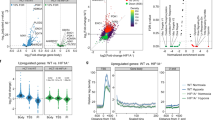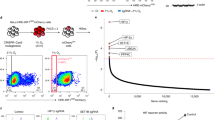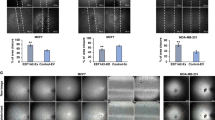Abstract
Hypoxia-inducible factor-1α (HIF-1α) is a principal regulator of angiogenesis and other cellular responses to hypoxic stress in both normal and tumor cells. To identify novel mechanisms that regulate expression of HIF-1α, we designed a genome-wide screen for expressed sequence tags (ESTs) that when transcribed in the antisense direction increase production of the HIF-1α target, vascular endothelial growth factor (VEGF), in human breast cancer cells. We discovered that heat shock factor (HSF) proteins 2 and 4—which previously have been implicated in the control of multiple genes that modulate cell growth and differentiation and protect against effects of environmental and cellular stresses—function together to maintain a steady state level of HIF-1α transcription and VEGF production in these cells. We show both HSFs bind to discontinuous heat shock element (HSE) sequences we identified in the HIF-1α promoter region and that downregulation of either HSF activates transcription of HIF-1α. We further demonstrate that HSF2 and HSF4 displace each other from HSF/HSE complexes in the HIF-1α promoter so that HIF-1α transcription is also activated by overexpression of either HSFs. These results argue that HSF2 and HSF4 regulate transcription of HIF-1α and that a critical balance between these HSF is required to maintain HIF-α expression in a repressed state. Our findings reveal a previously unsuspected role for HSFs in control of VEGF and other genes activated by canonical HIF-1α-mediated signaling.
This is a preview of subscription content, access via your institution
Access options
Subscribe to this journal
Receive 50 print issues and online access
$259.00 per year
only $5.18 per issue
Buy this article
- Purchase on Springer Link
- Instant access to full article PDF
Prices may be subject to local taxes which are calculated during checkout






Similar content being viewed by others
Accession codes
References
Akerfelt M, Henriksson E, Laiho A, Vihervaara A, Rautoma K, Kotaja N et al. (2008). Promoter ChIP-chip analysis in mouse testis reveals Y chromosome occupancy by HSF2. Proc Natl Acad Sci USA 105: 11224–11229.
Akerfelt M, Trouillet D, Mezger V, Sistonen L . (2007). Heat shock factors at a crossroad between stress and development. Ann NY Acad Sci 1113: 15–27.
Bos R, Zhong H, Hanrahan CF, Mommers EC, Semenza GL, Pinedo HM et al. (2001). Levels of hypoxia-inducible factor-1 alpha during breast carcinogenesis. J Natl Cancer Inst 93: 309–314.
Brahimi-Horn MC, Pouyssegur J . (2007). Harnessing the hypoxia-inducible factor in cancer and ischemic disease. Biochem Pharmacol 73: 450–457.
Busca R, Berra E, Gaggioli C, Khaled M, Bille K, Marchetti B et al. (2005). Hypoxia-inducible factor 1{alpha} is a new target of microphthalmia-. J Cell Biol 170: 49–59.
Chang Y, Ostling P, Akerfelt M, Trouillet D, Rallu M, Gitton Y et al. (2006). Role of heat-shock factor 2 in cerebral cortex formation and as a regulator of p35 expression. Genes Dev 20: 836–847.
Chi NC, Karliner JS . (2004). Molecular determinants of responses to myocardial ischemia/reperfusion injury: focus on hypoxia-inducible and heat shock factors. Cardiovasc Res 61: 437–447.
Fraisl P, Mazzone M, Schmidt T, Carmeliet P . (2009). Regulation of angiogenesis by oxygen and metabolism. Dev Cell 16: 167–179.
Fujimoto M, Izu H, Seki K, Fukuda K, Nishida T, Yamada S et al. (2004). HSF4 is required for normal cell growth and differentiation during mouse lens development. EMBO J 23: 4297–4306.
Fujimoto M, Oshima K, Shinkawa T, Wang BB, Inouye S, Hayashida N et al. (2008). Analysis of HSF4 binding regions reveals its necessity for gene regulation during development and heat shock response in mouse lenses. J Biol Chem 283: 29961–29970.
Fujimoto M, Nakai A . (2010). The heat shock factor family and adaptation to proteotoxic stress. FEBS J 277: 4112–4125.
Fukumura D, Xavier R, Sugiura T, Chen Y, Park EC, Lu N et al. (1998). Tumor induction of VEGF promoter activity in stromal cells. Cell 94: 715–725.
Isaacs JS, Jung YJ, Mimnaugh EG, Martinez A, Cuttitta F, Neckers LM . (2002). Hsp90 regulates a von Hippel Lindau-independent hypoxia-inducible factor-1 alpha-degradative pathway. J Biol Chem 277: 29936–29944.
Jiang BH, Agani F, Passaniti A, Semenza GL . (1997). V-SRC induces expression of hypoxia-inducible factor 1 (HIF-1) and transcription of genes encoding vascular endothelial growth factor and enolase 1: involvement of HIF-1 in tumor progression. Cancer Res 57: 5328–5335.
Loison F, Debure L, Nizard P, le Goff P, Michel D, le Drean Y . (2006). Up-regulation of the clusterin gene after proteotoxic stress: implication of HSF1-HSF2 heterocomplexes. Biochem J 395: 223–231.
Lu Q, Wei W, Kowalski PE, Chang AC, Cohen SN . (2004). EST-based genome-wide gene inactivation identifies ARAP3 as a host protein affecting cellular susceptibility to anthrax toxin. Proc Natl Acad Sci USA 101: 17246–17251.
Mathew A, Mathur SK, Jolly C, Fox SG, Kim S, Morimoto RI . (2001). Stress-specific activation and repression of heat shock factors 1 and 2. Mol Cell Biol 21: 7163–7171.
Mazure NM, Chen EY, Laderoute KR, Giaccia AJ . (1997). Induction of vascular endothelial growth factor by hypoxia is modulated by a phosphatidylinositol 3-kinase/Akt signaling pathway in Ha-ras-transformed cells through a hypoxia inducible factor-1 transcriptional element. Blood 90: 3322–3331.
Mazure NM, Chen EY, Laderoute KR, Giaccia AJ . (1996). Oncogenic transformation and hypoxia synergistically act to modulate vascular endothelial growth factor expression. Cancer Res 56: 3436–3440.
Min JN, Zhang Y, Moskophidis D, Mivechi NF . (2004). Unique contribution of heat shock transcription factor 4 in ocular lens development and fiber cell differentiation. Genesis 40: 205–217.
Minet E, Mottet D, Michel G, Roland I, Raes M, Remacle J et al. (1999). Hypoxia-induced activation of HIF-1: role of HIF-1alpha-Hsp90 interaction. FEBS Lett 460: 251–256.
Morimoto RI . (2008). Proteotoxic stress and inducible chaperone networks in neurodegenerative disease and aging. Genes Dev 22: 1427–1438.
Murphy LA, Wilkerson DC, Hong Y, Sarge KD . (2008). PRC1 associates with the hsp70i promoter and interacts with HSF2 during mitosis. Exp Cell Res 314: 2224–2230.
Nakai A, Tanabe M, Kawazoe Y, Inazawa J, Morimoto RI, Nagata K . (1997). HSF4, a new member of the human heat shock factor family which lacks properties of a transcriptional activator. Mol Cell Biol 17: 469–481.
Nardinocchi L, Puca R, Guidolin D, Belloni AS, Bossi G, Michiels C et al. (2009). Transcriptional regulation of hypoxia-inducible factor 1alpha by HIPK2 suggests a novel mechanism to restrain tumor growth. Biochim Biophys Acta 1793: 368–377.
Ng YS, Krilleke D, Shima DT . (2006). VEGF function in vascular pathogenesis. Exp Cell Res 312: 527–537.
Olenyuk BZ, Zhang GJ, Klco JM, Nickols NG, Kaelin WG, Dervan PB . (2004). Inhibition of vascular endothelial growth factor with a sequence-specific hypoxia response element antagonist. Proc Natl Acad Sci USA 101: 16768–16773.
Ostling P, Bjork JK, Roos-Mattjus P, Mezger V, Sistonen L . (2007). Heat shock factor 2 (HSF2) contributes to inducible expression of hsp genes through interplay with HSF1. J Biol Chem 282: 7077–7086.
Page EL, Robitaille GA, Pouyssegur J, Richard DE . (2002). Induction of hypoxia-inducible factor-1alpha by transcriptional and translational mechanisms. J Biol Chem 277: 48403–48409.
Pipinikas CP, Carter ND, Corbishley CM, Fenske CD . (2008). HIF-1alpha mRNA gene expression levels in improved diagnosis of early stages of prostate cancer. Biomarkers 13: 680–691.
Pirkkala L, Nykanen P, Sistonen L . (2001). Roles of the heat shock transcription factors in regulation of the heat shock response and beyond. FASEB J 15: 1118–1131.
Pore N, Liu S, Shu HK, Li B, Haas-Kogan D, Stokoe D et al. (2004). Sp1 is involved in Akt-mediated induction of VEGF expression through an HIF-1-independent mechanism. Mol Biol Cell 15: 4841–4853.
Pouyssegur J, Dayan F, Mazure NM . (2006). Hypoxia signalling in cancer and approaches to enforce tumour regression. Nature 441: 437–443.
Sandqvist A, Bjork JK, Akerfelt M, Chitikova Z, Grichine A, Vourc'h C et al. (2009). Heterotrimerization of heat-shock factors 1 and 2 provides a transcriptional switch in response to distinct stimuli. Mol Biol Cell 20: 1340–1347.
Schafer C, Clapp P, Welsh MJ, Benndorf R, Williams JA . (1999). HSP27 expression regulates CCK-induced changes of the actin cytoskeleton in CHO-CCK-A cells. Am J Physiol 277: C1032–C1043.
Semenza GL . (2003). Targeting HIF-1 for cancer therapy. Nat Rev Cancer 3: 721–732.
Somasundaram T, Bhat SP . (2004). Developmentally dictated expression of heat shock factors: exclusive expression of HSF4 in the postnatal lens and its specific interaction with alphaB-crystallin heat shock promoter. J Biol Chem 279: 44497–44503.
Tsuzuki Y, Fukumura D, Oosthuyse B, Koike C, Carmeliet P, Jain RK . (2000). Vascular endothelial growth factor (VEGF) modulation by targeting hypoxia-inducible factor-1alpha--> hypoxia response element--> VEGF cascade differentially regulates vascular response and growth rate in tumors. Cancer Res 60: 6248–6252.
Wartenberg M, Donmez F, Ling FC, Acker H, Hescheler J, Sauer H . (2001). Tumor-induced angiogenesis studied in confrontation cultures of multicellular tumor spheroids and embryoid bodies grown from pluripotent embryonic stem cells. FASEB J 15: 995–1005.
Xing H, Wilkerson DC, Mayhew CN, Lubert EJ, Skaggs HS, Goodson ML et al. (2005). Mechanism of hsp70i gene bookmarking. Science 307: 421–423.
Yamamoto N, Takemori Y, Sakurai M, Sugiyama K, Sakurai H . (2009). Differential recognition of heat shock elements by members of the heat shock transcription factor family. FEBS J 276: 1962–1974.
Zhang J, Goodson ML, Hong Y, Sarge KD . (2008). MEL-18 interacts with HSF2 and the SUMO E2 UBC9 to inhibit HSF2 sumoylation. J Biol Chem 283: 7464–7469.
Zhang Y, Frejtag W, Dai R, Mivechi NF . (2001). Heat shock factor-4 (HSF-4a) is a repressor of HSF-1 mediated transcription. J Cell Biochem 82: 692–703.
Acknowledgements
The study was supported by funds from the Kwoh-Ting Li Professorship to SNC, and by a grant from the National Foundation for Cancer Research (NFCR) to SNC.
Author information
Authors and Affiliations
Corresponding author
Ethics declarations
Competing interests
The authors declare no conflict of interest.
Rights and permissions
About this article
Cite this article
Chen, R., Liliental, J., Kowalski, P. et al. Regulation of transcription of hypoxia-inducible factor-1α (HIF-1α) by heat shock factors HSF2 and HSF4. Oncogene 30, 2570–2580 (2011). https://doi.org/10.1038/onc.2010.623
Received:
Revised:
Accepted:
Published:
Issue Date:
DOI: https://doi.org/10.1038/onc.2010.623
Keywords
This article is cited by
-
Mint3-depletion-induced energy stress sensitizes triple-negative breast cancer to chemotherapy via HSF1 inactivation
Cell Death & Disease (2023)
-
HSF4 promotes tumor progression of colorectal cancer by transactivating c-MET
Molecular and Cellular Biochemistry (2023)
-
Chromatin accessibility landscape and active transcription factors in primary human invasive lobular and ductal breast carcinomas
Breast Cancer Research (2022)
-
FGD3 binds with HSF4 to suppress p65 expression and inhibit pancreatic cancer progression
Oncogene (2022)
-
Heat increases full-length SMN splicing: promise for splice-augmenting therapies for SMA
Human Genetics (2022)



